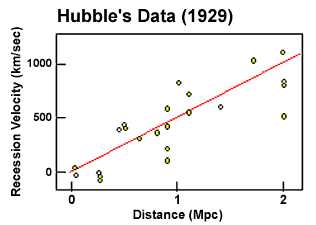The principles of cosmic homogeneity and isotropy guide investigations into the structure of the very large. Newton believed that the universe should be reckoned to be symmetrical on average with respect to the distribution of matter within it. In America in 1913, Vesto Melvin Slipher discovered that the 'nebulae' he was studying were receeding, or apparently moving away, at up to millions of miles per hour. He found this by being a pioneer in the methods of using Doppler shifts in spectral lines to find velocities. It is a simple method in principle - first determine the absorption spectral line of an element on earth, then look for that line in distant objects, and measure the wavelength shift in the line. The velocity of the object will shift the spectral line to the blue if the light source is approaching, to the red if it is receeding.
In Einstein's equations for a static universe, the Lambda constant is an unusual force; it grows with distance and is independant of mass. Willem deSitter formulated what he considered a non-physical 'empty' universe which predicted a red shift, increasing for objects at greater distances.
In 1922, a prolific Russian mathematician Alexander Friedmann presented an interpretation of gravitational field theory which showed that two non-static universes were possible, and that the universe must be either contracting or expanding, not static. The critical density for which the universe will just expand forever, that is, the limit of the mass of an open universe, is named after Friedmann - the Friedmann density.
Although Einstein was at sort of an impass, the astronomers kept working, and in 1923 Edwin Hubble, another American, discovered that the Andromeda galaxy was more than a million lightyears away, and that the Milky Way was no more than 100,000 lightyears across. He measured these great distances by using the standard candle cephid variables, stars whose intrinsic brightness and periodicity were predictably related. He used the inverse square law: R = (Iintrinsic/Iobserved)1/2 to discover the distance.
From 1928-1936, Hubble and Humason intently studied the spectra of distant 'nebula,' many of which they found to be seperate galaxies, and most of which were found to be redshifted. The intensity of the redshift was (and is) proportional to the distance from our Milky Way. In the late 1920's, Hubble had data enough to assert that the universe at large was expanding:


Where the regression line represents a constant, H-naught, the Hubble constant. Hubble's first estimate of the Hubble constnat was about 1 order of magnitude higher than the one we measure today.
"Hubble's law" is a simple linear relationship : H = v/r, where v is recessional velocity, r is distance, and the value of H depends on the cosmological model you are testing. Or if you like differential equations, H = dr/(r dt).
In the aftermath of Friedmann's work and the impeccable data accumulated by Hubble and Humason, Einstein was convinced of a non-static universe by 1933.
The measurements of spectroscopic redshift championed by Hubble and Humason at the 100 inch telescope at Mount Wilson were continued on a new 200 inch telescope in the 1940's. By the 1950's and 1960's, it was Allan Sandage taking spectroscopic pictures from the great telescope. He found galaxies at distanced including 6 billion lightyears. Because of large average local velocities, not every galaxy is moving away. For example, the Andromeda galaxy is blue-shifted, but it is closer than any other galaxy. And Hubble's discovery does not contradict isotropy - ostensibly an observer in a distant galaxy will see the same universe, and our galaxy will appear to be receeding from such an observer.
Measurements of redshifts from distant quasars are still conducted today, and in 1998, supernova data revealed remarkably that the universe is accelerating in its expansion.